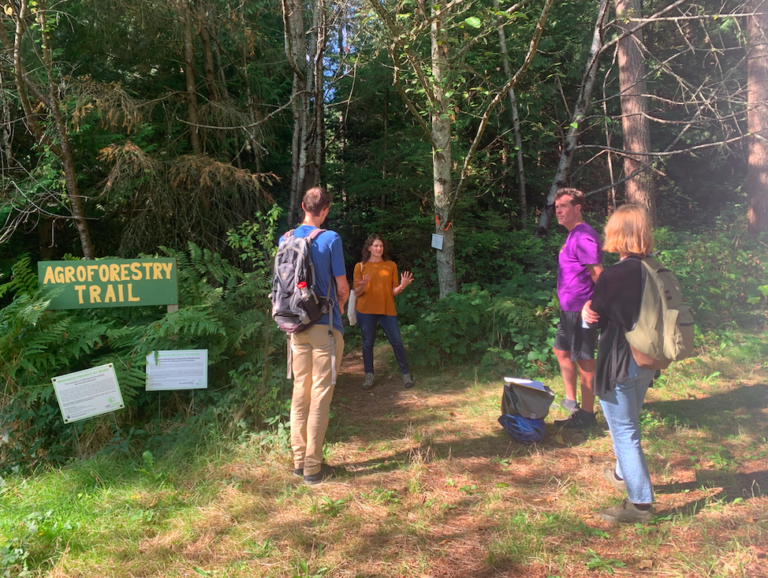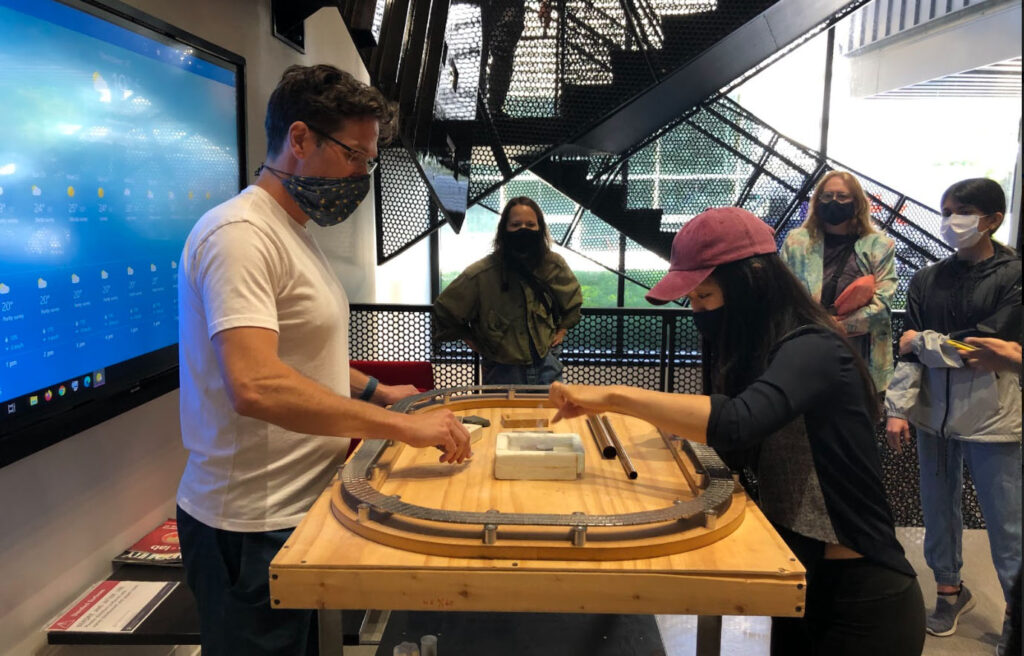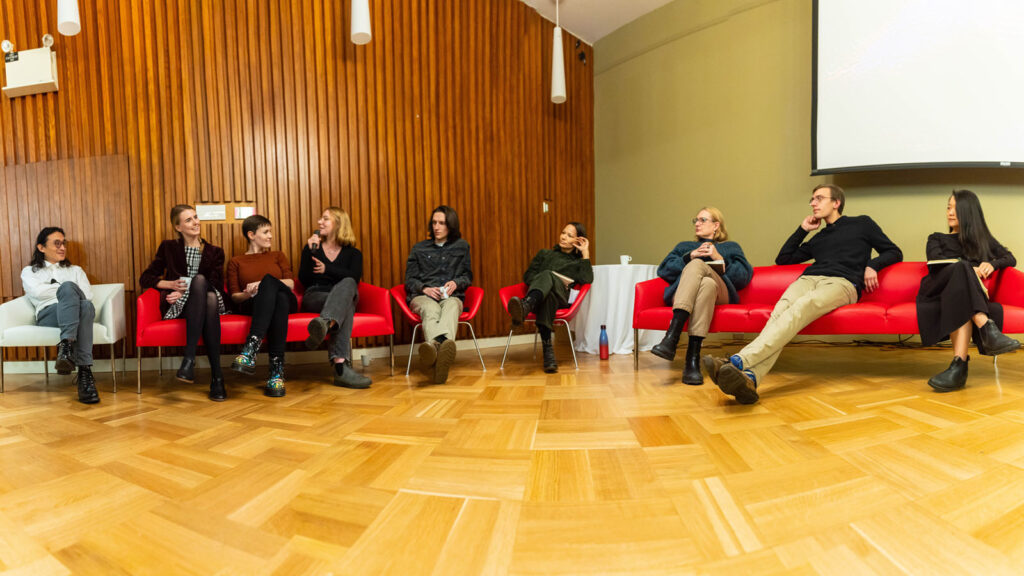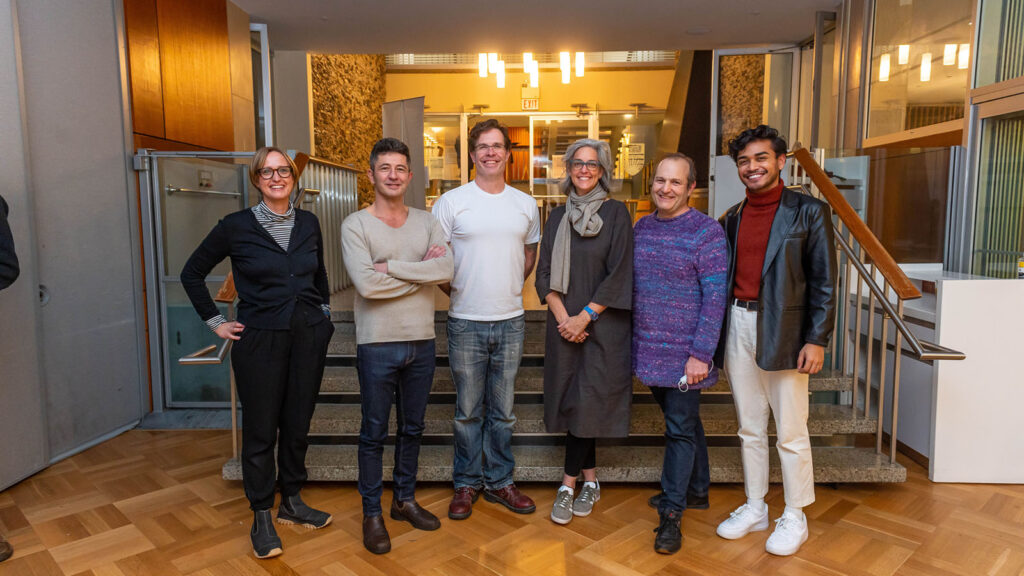“The biggest breakthroughs in science have always come out of paradigm shifts, or the moment that someone sees something new in what they previously took for granted,” said James Day, Research Associate and Program Manager for UBC’s Ars Scientia research cluster.
“For example, in the 1940s, Richard Feynman devised a language of squiggles and shapes—the Feynman diagrams—to simplify equations in physics, forever altering the way that physicists view the world.”
In his role as Ars Scientia Program Coordinator, Day has spent the last year guiding a nascent residency program linking local artists with UBC physicists. It has been an experience that has found him enthusiastically outside of his comfort zone, challenging him to think more deeply about how science interacts—and is perceived by—the world outside the lab.

Artist Holly Schmidt leads a sensory walk of UBC Farm. Pictured, left to right; Daniel Korchinski, Holly Schmidt, James Day, Rysa Greenwood. Image credit: Marcus Prasad.
What’s in a word?
There is often a lot of meaning packed into the language of physics. Words we use frequently in the lab or in our publications convey complex ideas and are useful in communicating to other scientists about our research. However, to non-scientists, these words have little meaning and are often essentially jargon. The result is that the language that serves physicists can also be an obstacle to those outside of science.
This disconnect between how physicists speak and what artists and others who work outside of science understand of that language became apparent throughout the residencies.
“Finding a common ground in language was sometimes difficult, but it was also fun,” said Day. “You can’t presume that you share an understanding of key terms; I found that when we were using words that physicists commonly understand one way, the artists understood those words differently.”
Being forced to consider how some words are used differently in different disciplines and having to explain their meaning in unfamiliar contexts caused researchers to think about how well they understand certain concepts. Artists and scientists observe the world from different but not necessarily opposing perspectives, and if they are able to talk about what they see, the effect is very powerful.
“I appreciated how the artists pushed us to contemplate topics we thought we understood pretty well; they led me to consider more deeply what I mean, what I intend, and where I am coming from,” said Day. “Working with the artists took us outside of our science bubble and made us consider analogies we had been using, that we had assumed were functional, and seeing where those broke down for people outside of science. Working with people from other disciplines forces us as scientists to find effective ways to communicate about our work.”

James Day demonstrates superconductivity to artist Josephine Lee during an Ars Scientia tour of the Stewart Blusson Quantum Matter Institute on June 18, 2021.
Beyond “multidisciplinary”
Opportunities like the Ars Scientia residencies program and other art-science initiatives are especially important to students and early career researchers, who can benefit from the breadth of perspective interdisciplinary experiences can offer.
In his 1995 paper Fruits, Salads, and Smoothies, Wayne State University researcher Moti Nissani proposed that “multidisciplinary” is a bowl of fruit; “interdisciplinary” is a fruit salad. “Transdisciplinary” is a smoothie, a transformation that takes what we understand to be fruit and makes something completely new: this, according to Day, is what we need to be doing more of in academia.
“When scientists work with artists, they are exposing themselves to questions they might never be asked by another scientist in their field,” said Day. “We don’t always question if we truly understand what we have learned. Sometimes an artist will ask a question that is so fundamental, it forces a researcher to look at their area of expertise in a completely new light. That is so beneficial, especially early on.”
Much depends on a broader understanding of what scientists do and why, from funding of research projects to the public perception of the value of fundamental science. Inter- and transdisciplinary partnerships invite participation from excluded groups.
This exchange is beneficial for artists as well, who benefit from access to scientific spaces not generally accessible to the public. With opportunities to peer into otherwise restricted spaces, artists can find meaning in research before it becomes public knowledge; this enables them to shape the conversation in interesting and potentially meaningful ways.
“Someone who thinks differently than you do offers you a chance to see a little more of the world than you might otherwise,” said Day. “It’s impossible to imagine where the next paradigm shift might come from but by partnering artists and physicists, we create the potential for a clash of views that lead to creative ideas we may not have generated otherwise.”

Ars Scientia residencies panel at Signals and Apparatuses, November 25, 2021. Pictured, left to right: Khan Lee, Sarah Morris, Alannah Hallas, Rysa Greenwood, Luke Reynolds, Justine A. Chambers, Kelly Lycan, Daniel Korchinski, and Josephine Lee. Image credit: Paul Joseph/UBC.
What is Ars Scientia?
Ars Scientia is a transdisciplinary project that connects physicists and artists in an effort to find shared ways of communicating about science and explaining the world around us.
Ars Scientia is co-led by Andrea Damascelli, UBC PHAS Professor and Blusson QMI Scientific Director; Jeremy Heyl, UBC PHAS Professor; and Shelly Rosenblum, Curator of Academic Programs at the Belkin, and supported by a team of staff including Program Manager James Day.

The Ars Scientia team. Pictured, left to right: Tatiana Mellema, Andrea Damascelli, James Day, Shelly Rosenblum, Jeremy Heyl, Marcus Prasad. Image credit: Paul Joseph/UBC.
Ars Scientia partnered UBC physics faculty (Alannah Hallas, Kirk Madison) and graduate students (Rysa Greenwood, Daniel Korchinski, Sarah Morris, and Luke Reynolds) with Vancouver-based artists Justine A. Chambers, Josephine Lee, Khan Lee, and Kelly Lycan over a six-month period. Ars Scientia leads instructed the teams to meet, to attend seminars, but generally left the experience open. There was no requirement for a tangible outcome, but they would need to present at a public symposium after those six months.
The symposium was held on November 25. Read more: arsscientia.ubc.ca/news/signals-and-apparatuses
In 2021, Ars Scientia was awarded two years of funding through the UBC Research Excellence Cluster program, an interdisciplinary initiative jointly created by the Vice-President, Research & Innovation and the Provost & Vice-President, Academic, and supported by UBC’s Academic Excellence Fund.


